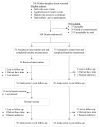Two-year outcomes of a randomized, family-based substance use prevention trial for Asian American adolescent girls
- PMID: 23276322
- PMCID: PMC4135055
- DOI: 10.1037/a0030925
Two-year outcomes of a randomized, family-based substance use prevention trial for Asian American adolescent girls
Abstract
Asian Americans have been largely ignored in the prevention outcome literature. In this study, we tested a parent-child program with a sample of Asian American adolescent girls and their mothers, and evaluated the program's efficacy on decreasing girls' substance use and modifying risk and protective factors at individual, family, and peer levels. A total of 108 Asian American mother-daughter dyads recruited through online advertisements and from community service agencies were randomly assigned to an intervention arm (n = 56) or to a test-only control arm (n = 52). The intervention consisted of a nine-session substance abuse prevention program, delivered entirely online. Guided by family interaction theory, the prevention program aimed to strengthen the quality of girls' relationships with their mothers while increasing girls' resilience to resist substance use. Intent-to-treat analyses showed that at 2-year follow-up, intervention-arm dyads had significantly higher levels of mother-daughter closeness, mother-daughter communication, maternal monitoring, and family rules against substance use compared with the control-arm dyads. Intervention-arm girls also showed sustained improvement in self-efficacy and refusal skills and had lower intentions to use substances in the future. Most important, intervention-arm girls reported fewer instances of alcohol and marijuana use and prescription drug misuse relative to the control-arm girls. The study suggests that a culturally generic, family-based prevention program was efficacious in enhancing parent-child relationships, improving girls' resiliency, and preventing substance use behaviors among Asian American girls.
PsycINFO Database Record (c) 2013 APA, all rights reserved.
References
-
- Adhikari SB, Chen M, Ahijevych KL. Tobacco use behavior, knowledge, and beliefs about smoking, among Asian American youth in Northeast Ohio. Asian Services in Action, Inc.; Cleveland, OH: 2002.
-
- Allison F. The current state of gender-specific delinquency programming. Journal of Criminal Justice. 2008;36(3):262–269. doi: 10.1016/j.jcrimjus.2008.04.007.
-
- Armsden G, Greenberg M. The inventory of parent and peer attachment: Individual differences and their relationship to psychological well-being in adolescence. Journal of Youth and Adolescence. 1987;16(5):427–454. doi: 10.1007/BF02202939. - PubMed
-
- Au JG, Donaldson SI. Social influences as explanations for substance use differences among Asian-American and European-American adolescents. Journal of Psychoactive Drugs. 2000;32(1):15–23. doi: 10.1080/02791072.2000.10400208. - PubMed
-
- Bhattacharya G. Drug abuse risks for acculturating immigrant adolescents: Case study of Asian Indians in the United States. Health and Social Work. 2002;27:175–183. - PubMed
Publication types
MeSH terms
Grants and funding
LinkOut - more resources
Full Text Sources
Other Literature Sources
Medical


